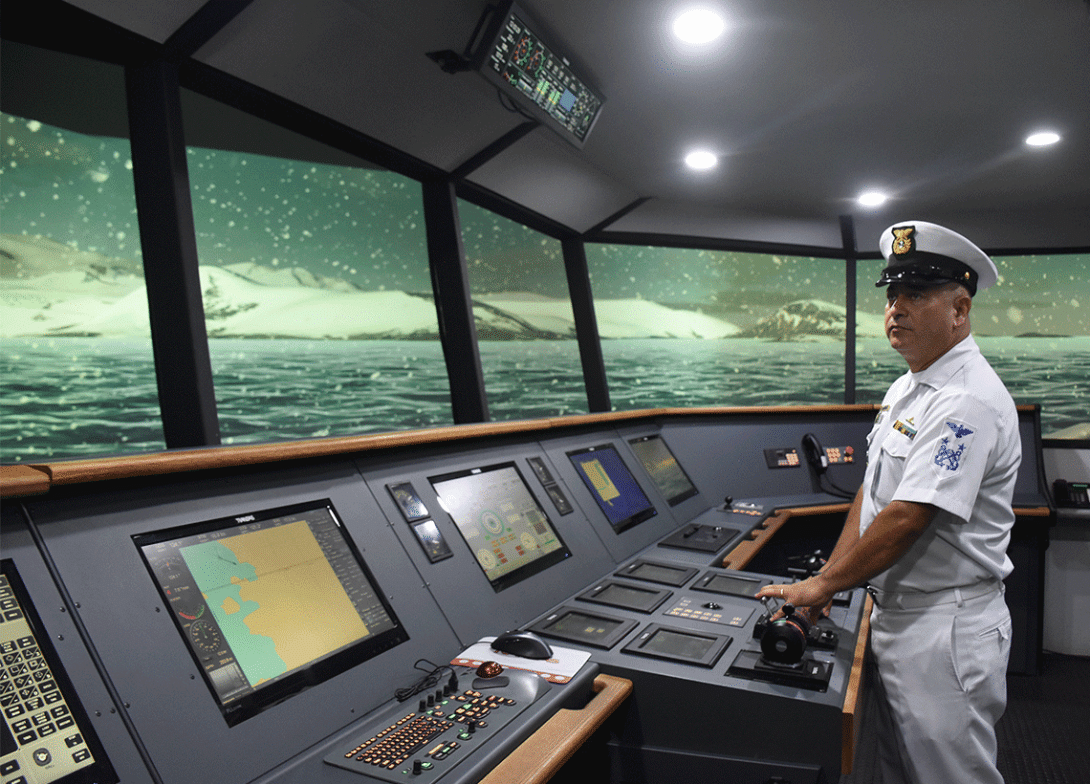A sailor who gets ready to sail in the icy waters of the white continent no longer has to wait hundreds of miles and cross the ocean because the Naval Academy of Cadets 'Almirante Padilla' (ENAP), the maritime university of Colombia and alma mater of the Naval Officers, can sail now by the Bay of Cierva Cove, in Antarctica, thanks to the technological capacity and simulated scenarios provided by the Center for Research, Development and Innovation for Maritime Activities (CIDIAM).
CIDIAM counts on seven simulators for the training of noncommissioned officers, officers and maritime professionals in simulated scenarios such as navigation channels, ports, units and other maritime and fluvial infrastructure, contributing to the strengthening of decision-making and reducing the costs of maneuvers in real scenarios. Among these simulators it is important to mention the full mission 300 degrees bridge, certified in category A1 by the International Maritime Organization, unique in Colombia and South America.
In addition to the Bay of Cierva Cove, the Naval School of Cadets has designed a series of simulated scenarios that are very faithful to reality and help to train skills in seafarers. "In the same way, we have designed the main ports of Colombia: Cartagena and Barranquilla, in the Caribbean; Buenaventura, in the Pacific, and many other virtual scenarios of different bodies of water" said Captain Miguel Andrés Garnica López, Director of the Center for Scientific Research of the Naval School of Cadets.
Committed human resources
The generation of these scenarios is possible thanks to the work carried out by the staff of the Naval School of Cadets in the collection of information, the production of data that are provided by other institutions and mathematical models. "In addition, it has the ability to design the ships, which are in the same way part of each virtual scenario. These scenarios are carried out by our officers, non-commissioned officers and engineers at CIDIAM, with the participation of naval engineers of the School of Naval Engineering of ENAP, who provide all their knowledge and experience so that the behavior of the ship obeys the reality ", added Captain Garnica.
Training and preparation
"Through our simulators to date we have trained and prepared more than 2,000 cadets, more than 1,000 crew members of our units afloat in very special maneuvers, especially focused on emergencies. More than 56 people from different maritime associations have also trained there. One of these trainings led to the entry of a gas ship for the first time to one of the maritime terminals in the Bay of Cartagena," says Captain Garnica.
The Naval Academy of Cadets 'Almirante Padilla', as maritime university, implements research projects, constantly strengthens the formative research processes of students and coordinates with other institutions at national and international level to solve needs of the Navy of Colombia and the country, with the firm purpose of contributing to the Maritime Power.
Source: Naval School of Cadets 'Almirante Padilla'





